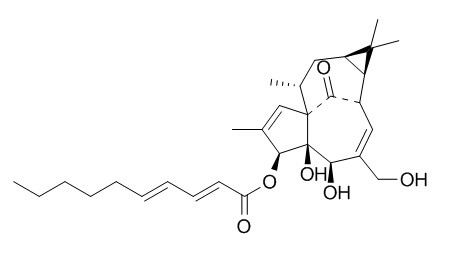3-O-(2'E,4'E-Decadienoyl)ingenol
3-O-(2'E,4'E-Decadienoyl)ingenol , one toxic terpenoid from raw Gansui.3-O-(2′E,4′E-decadienoyl)-ingenol and 3-O-(2′E,4′Z-decadienoyl)-20-O-acetyl-ingenol show cytotoxicity on Namalwa cells with IC 50 values of 7.6 and 5.2 umol·L-1, respectively.
Inquire / Order:
manager@chemfaces.com
Technical Inquiries:
service@chemfaces.com
Tel:
+86-27-84237783
Fax:
+86-27-84254680
Address:
1 Building, No. 83, CheCheng Rd., Wuhan Economic and Technological Development Zone, Wuhan, Hubei 430056, PRC
Providing storage is as stated on the product vial and the vial is kept tightly sealed, the product can be stored for up to
24 months(2-8C).
Wherever possible, you should prepare and use solutions on the same day. However, if you need to make up stock solutions in advance, we recommend that you store the solution as aliquots in tightly sealed vials at -20C. Generally, these will be useable for up to two weeks. Before use, and prior to opening the vial we recommend that you allow your product to equilibrate to room temperature for at least 1 hour.
Need more advice on solubility, usage and handling? Please email to: service@chemfaces.com
The packaging of the product may have turned upside down during transportation, resulting in the natural compounds adhering to the neck or cap of the vial. take the vial out of its packaging and gently shake to let the compounds fall to the bottom of the vial. for liquid products, centrifuge at 200-500 RPM to gather the liquid at the bottom of the vial. try to avoid loss or contamination during handling.
Phytomedicine.2023, 116:154841.
Bull.Natl.Mus.Nat.Sci.,Ser.B.2024, 50(2):79�C86
J Appl Biol Chem.2024, 67:33,238-244
Pharmaceuticals (Basel).2024, 17(3):341.
Journal of Applied Biology & Biotechnology2023,11(4):148-158
Biomed Pharmacother.2024, 179:117410.
J of Liquid Chromatography & Related Technologies2024, 47(1-5):14-25.
Evid Based Complement Alternat Med.2017, 2017:1583185
Oxid Med Cell Longev.2020, 2020:8887251.
Int. J. Mol. Sci.2023, 24(20),15294.
Related and Featured Products
BMC Complem. Altern. M., 2016, 16(1):1-8.
Ultra-performance liquid chromatography-quadrupole/time-of-flight mass spectrometry analysis of the impact of processing on toxic components of Kansui Radix.[Reference:
WebLink]
Kansui Radix (Gansui in Chinese), the dried tuber of Euphorbia kansui, is a Chinese medicinal herb commonly used for the treatment of oedema and ascites with dyspnea. Because of its toxic nature, the herb is usually processed with vinegar to reduce the toxicity. A report has shown that the contents of toxic terpenoids in Gansui decreased after processing with vinegar. However, comprehensive comparison of the chemical profiles between vinegar-processed and raw Gansui has not yet been conducted.
METHODS AND RESULTS:
Results showed that processing with vinegar caused conspicuous chemical changes. Among the altered components, 11 toxic terpenoids, 3-O-benzoyl-13-O- dodecanoylingenol/20-O-benzoyl-13-O-dodecanoylingenol, kansuinine D, kansuinine A, 3-O-benzoyl-13-O-dodecanoylingenol/20-O-benzoyl-13-O-dodecanoylingenol, 3-O- benzoylingenol/20-O-benzoylingenol, 20-O-(2′E,4′Z-decadienoyl)ingenol/20-O-(2′E,4′E- decadienoyl)ingenol/3-O-(2′E,4′Z-decadienoyl)ingenol/3-O-(2'E,4'E-Decadienoyl)ingenol ,
3-O-(2′E,4′Z-decadienoyl)-20-deoxyingenol,3-O-(2′E,4′Z-,ecadienoyl)-5-O-acetylingenol,3-O-(2′E,4′Z-decadienoyl)-20-O-acetylingenol,3-O-(2,3-dimethylbutanoyl)-13-O-dodecanoylingenol, were tentatively identified. The contents of most of these terpenoids were obviously decreased after processing with reductions of 6.66–95.25 %.



